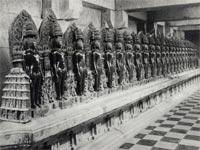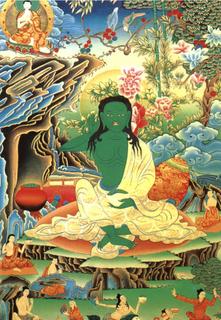"Call a rose by any name, it still remains a rose"
Facts donot change with the names we humans ascribe to them.
It is said that Kailash parvat is itself a linga, the symbol of Shiva on Earth.
Some tales on Kailash, the abode of Shiva.
A great mass of black rock soaring to over 22,000 feet, Mt. Kailash has the unique distinction of being the world's most venerated holy place at the same time that it is the least visited. The supremely sacred site of four religions and billions of people, Kailash is seen by no more than a few thousand pilgrims each year.
This curious fact is explained by the mountain's remote location in far western Tibet. No planes, trains or buses journey anywhere near the region and even with rugged over-land vehicles the journey still requires weeks of difficult, often dangerous travel. The weather, always cold, can be unexpectedly treacherous and pilgrims must carry all the supplies they will need for the entire journey.
How long have people been coming to this sacred mountain?
The answers are lost in antiquity, before the dawn of Hinduism, Jainism or Buddhism.
The answers are lost in antiquity, before the dawn of Hinduism, Jainism or Buddhism.
The cosmologies and origin myths of each of these religions speak of Kailash as the mythical Mt. Meru, the Axis Mundi, the center and birth place of the entire world. The mountain was already legendary before the great Hindu epics, the Ramayana and the Mahabharata, were written.
Indeed, Kailash is so deeply embedded in the myths of ancient Asia that it was perhaps a sacred place of another era, another civilization, now long gone and forgotten.
Hindus believe Mt.Kailash to be the abode of Lord Shiva. Like many of the Hindu gods, Shiva is a character of apparent contradictions. He at once the Lord of Yoga and therefore the ultimate renunciate ascetic, yet he is also the divine master of Tantra, the esoteric science that regards sexual union as the most perfect path to spiritual enlightenment. According to legend, immortal Shiva lives atop Kailash where he spends his time practicing yogic austerities, making joyous love with his divine consort, Parvati, and smoking ganja, the sacred herb known in the west as marijuana, Hindus do not interpret Shiva's behaviors as contradictory however, but rather see in him a deity who has wisely integrated the extremes of human nature and thus transcended attachment to any particular, and limited, way of being.
For a Hindu, to make the arduous pilgrimage to Kailash and have the darshan (divine view) of Shiva's abode is to attain release from the clutches of ignorance and delusion.
I have tried to bring out some references of Kailash in other popular and not-so-popular religions of the world.
Paganism
The Greek God of wine, Dionysus, has a startling similarity with Shiva and is said to have been born and brought up on Mt. Nysa, which could be none other than Mt. Kailash.
The Greek God of wine, Dionysus, has a startling similarity with Shiva and is said to have been born and brought up on Mt. Nysa, which could be none other than Mt. Kailash.
Jainism
The Jains call the mountain Astapada and believe it to be the place where Rishaba, the first of the twenty-four Tirthankaras attained liberation.
The Jains call the mountain Astapada and believe it to be the place where Rishaba, the first of the twenty-four Tirthankaras attained liberation.
Bon
Followers of Bon, Tibet's pre-Buddhist, shamanistic religion, call the mountain Tise and believe it to be the seat of the Sky Goddess Sipaimen. Additionally, Bon myths regard Tise as the sight of a legendary 12th century battle of sorcery between the Buddhist sage Milarepa and the Bon shaman Naro Bon-chung. Milarepa's defeat of the shaman displaced Bon as the primary religion of Tibet, firmly establishing Buddhism in its place.
Followers of Bon, Tibet's pre-Buddhist, shamanistic religion, call the mountain Tise and believe it to be the seat of the Sky Goddess Sipaimen. Additionally, Bon myths regard Tise as the sight of a legendary 12th century battle of sorcery between the Buddhist sage Milarepa and the Bon shaman Naro Bon-chung. Milarepa's defeat of the shaman displaced Bon as the primary religion of Tibet, firmly establishing Buddhism in its place.
Buddhism
The Buddha is believed to have magically visited Kailash in the 5th century BC although the religion of Buddhism only entered Tibet, via Nepal and India, in the 7th century AD.
The Buddha is believed to have magically visited Kailash in the 5th century BC although the religion of Buddhism only entered Tibet, via Nepal and India, in the 7th century AD.

Buddhist believe that Queen Maya, the Buddha's mother was carried here by the gods and washed prior to giving birth to the Buddha.Tibetan Buddhists call the mountain Kang Rimpoche, the 'Precious One of Glacial Snow', and regard it as the dwelling place of Demchog (also known as Chakrasamvara) and his consort, Dorje Phagmo. Three hills rising near Kang Rimpoche are believed to be the homes of the the Bodhisatvas Manjushri, Vajrapani, and Avalokiteshvara.During Kailash parikrama, one encounters a spot which claims to be footprint of Gautam Buddha.

Christianity
It is mentioned in Bhavishya Puran that Issa (Yeshuwa) lived in Himalayas after he survived crucifixion. Swami Abhedananda did visit Himis to find the same Buddhist scrolls that were found by Notovitch which claim that Yeshuwa (Jesus) survived crucifixion and lived in the Himalayas. Himis is very near Kailash and in fact it is great probability that Yeshuwa spent time in meditation at the same place where souls have attained liberation, the blessed land of Kailash, the abode of Shiva.
Hinduism
Mt. Meru and Sumeru is said to be none other than Mt. Kailash. Pandavas have climbed this mountain and attained liberation. Ravana did severe tapas near Kailash to please Shiva. All Gods, Sages, men, Danavas, Rakshashas, Gandharvas, Kinnars, Nagas etc. desirous of the divine blessings of Shiva have visited Kailash to pay their homage.
Mt. Meru and Sumeru is said to be none other than Mt. Kailash. Pandavas have climbed this mountain and attained liberation. Ravana did severe tapas near Kailash to please Shiva. All Gods, Sages, men, Danavas, Rakshashas, Gandharvas, Kinnars, Nagas etc. desirous of the divine blessings of Shiva have visited Kailash to pay their homage.
Additional Notes:
-Even till date the Chinese army has not been able to climb up Kailash. Each time they were obstructed by forces unknown to them.
-Pilgrims to Kailash, after the difficult journey getting there, are confronted with the equally arduous task of circumambulating the sacred peak. This walking around the mountain (clockwise for the Buddhists, counter-clockwise for Bon adherents) is known as a Kora, or Parikrama, and normally takes three days.
-In hopes of gaining extra merit or psychic powers however, some pilgrims will vary the tempo of their movement. A hardy few, practicing a secret breathing technique known as Lung-gom, will power themselves around the mountain in only one day. Others take two to three weeks for the Kora by making full body prostrations the entire way.

-It is believed that a pilgrim who completes 108 journeys around the mountain is assured enlightenment. -Most pilgrims to Kailash will also take a short plunge in the nearby, highly sacred (and very cold) Lake Manosaravar. The word 'manas' means mind or consciousness; the name Manosaravar means Lake of Consciousness and Enlightenment. Adjacent to Manosaravar is Rakas Tal or Rakshas, the Lake of Demons. Pilgrimage to this great sacred mountain and these two magical lakes is a life changing experience and an opportunity to view some of the most magical scenery on the entire planet.-For Tibetans, pilgrimage refers to the journey from ignorance to enlightenment, from self-centeredness and materialistic preoccupations to a deep sense of the relativity and interconnectedness of all life. -The Tibetan word for pilgrimage, neykhor, means "to circle around a sacred place," for the goal of pilgrimage is less to reach a particular destination than to transcend through inspired travel the attachments and habits of inattention that restrict awareness of a larger reality........By traveling to sacred sites, Tibetans are brought into living contact with the icons and energies of Tantric Buddhism. -The neys, or sacred sites themselves, through their geological features and the narratives of transformation attached to them, continually remind pilgrims of the liberating power of the Tantric Buddhist tradition.
-Even till date the Chinese army has not been able to climb up Kailash. Each time they were obstructed by forces unknown to them.
-Pilgrims to Kailash, after the difficult journey getting there, are confronted with the equally arduous task of circumambulating the sacred peak. This walking around the mountain (clockwise for the Buddhists, counter-clockwise for Bon adherents) is known as a Kora, or Parikrama, and normally takes three days.
-In hopes of gaining extra merit or psychic powers however, some pilgrims will vary the tempo of their movement. A hardy few, practicing a secret breathing technique known as Lung-gom, will power themselves around the mountain in only one day. Others take two to three weeks for the Kora by making full body prostrations the entire way.

-It is believed that a pilgrim who completes 108 journeys around the mountain is assured enlightenment. -Most pilgrims to Kailash will also take a short plunge in the nearby, highly sacred (and very cold) Lake Manosaravar. The word 'manas' means mind or consciousness; the name Manosaravar means Lake of Consciousness and Enlightenment. Adjacent to Manosaravar is Rakas Tal or Rakshas, the Lake of Demons. Pilgrimage to this great sacred mountain and these two magical lakes is a life changing experience and an opportunity to view some of the most magical scenery on the entire planet.-For Tibetans, pilgrimage refers to the journey from ignorance to enlightenment, from self-centeredness and materialistic preoccupations to a deep sense of the relativity and interconnectedness of all life. -The Tibetan word for pilgrimage, neykhor, means "to circle around a sacred place," for the goal of pilgrimage is less to reach a particular destination than to transcend through inspired travel the attachments and habits of inattention that restrict awareness of a larger reality........By traveling to sacred sites, Tibetans are brought into living contact with the icons and energies of Tantric Buddhism. -The neys, or sacred sites themselves, through their geological features and the narratives of transformation attached to them, continually remind pilgrims of the liberating power of the Tantric Buddhist tradition.
Essence:
Whatever be the way, whatever be the action, whatever be the motive, knowingly or unknowingly we all worship the One, the auspicious One, Shiva.










No comments:
Post a Comment